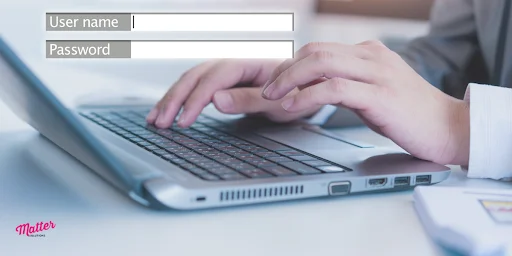Imagine spending months building the perfect business website, only to wake up one morning and find a hacker has wiped it all out.
This nightmare affects business owners all the time. But the worst part about it is losing your site. It also means losing your customers’ trust, your search visibility, and all your hard work.
Our team at Matter Solutions has spent years perfecting strategies to protect WordPress sites and keep companies secure.
Yes, we all think it can’t actually happen to us. But we know better, don’t we? The good news is that most of these problems are preventable if you take the right steps at the right time.
So, let’s look at how you can keep your website safe, starting with the common threats.
Common Threats to WordPress Sites
Most people imagine website threats as a single attack, but there are actually many ways hackers try to take over your site. Here’s how it can take place:
Brute Force Attacks
Brute force attacks happen when hackers use computer programs to guess your login details. Over 80% of web application attacks come from brute force attempts. These automated programs try thousands of username and password combinations until they find the right one.
DDoS Attacks
Have you ever been stuck in traffic because too many cars tried to use the same road? That’s what a DDoS attack does to your website. In this kind of attack, hackers send fake website traffic from hundreds of computers at once, overwhelming your server and taking your site offline.
Malware Infections
Malware behaves as a computer virus for websites. Once it gets onto your site, this harmful software can do serious damage. It can steal your customers’ personal information or redirect them to dangerous sites without anyone knowing. What’s more shocking, around 1% of all websites have malware right now. Terrible, isn’t it?
Weak Passwords
Would you use “password123” to protect your bank account? Probably not, but many website owners use simple passwords like this. like this. Yet weak passwords remain one of the most common ways hackers break into WordPress sites.
Outdated Plugins
WordPress plugins are like apps for your phone. They add cool features but need regular updates. You might be surprised to know that more than half of WordPress security threats come from outdated plugins.
Admin Vulnerabilities
Finally, the worst that can happen is a hacker getting into your admin account, giving them full control of your site. And you already know what that means: you could lose content, have malware installed, or see your site turned into a spam machine.
Now that you see where the risks are, you can start taking action to keep your site secure.
Use Strong Passwords and a Web Application Firewall
Strong passwords and a web application firewall work together like a locked door and a security guard for your website. You can try these methods to make sure your website stays safe.
Enable SSL and Choose Strong Passwords
First, let’s talk about SSL protection. This technology scrambles all the information between your website and visitors, and when it’s enabled, browsers show the green padlock that makes customers feel safe. Most web hosts now give you free SSL certificates through Let’s Encrypt.
Now, for passwords, a strong one should have at least 12 characters, including uppercase and lowercase letters, numbers, and symbols. Something like “BlueCat#47Mountain!” works well. You can also use a password generator to make one automatically.
Install a Reliable Web Application Firewall
A web application firewall checks every visitor to your site and blocks anything that seems suspicious before it gets in. If it’s set up right, it can stop more than 99% of attacks.
You’ve got two main options here. Cloud firewalls like Cloudflare filter website traffic through their own servers first, and security plugins like Wordfence work directly on your site. But both methods do a great job of stopping hackers midway.
Monitor Suspicious Activity Every Day
Lastly, always keep an eye on what’s happening with your site. Most security plugins show you real-time reports about login attempts and blocked attacks. You can also set up email alerts so you know right away if something unusual is happening.
Also, keep an eye on these areas:
- Take a quick look at your user accounts each week to spot any strangers.
- Watch out for failed login attempts to catch anyone trying to break in.
- Unexpected changes to files could mean malware slipped past your defenses.
Once these basic defenses are in place, secure your site during updates. The next step is protecting yourself when you install new plugins and themes.
How to Use Maintenance Mode Without Risking Security
When you’re updating your WordPress site, the last thing you want is for visitors to see broken pages or half-finished work. Maintenance mode plugins solve this problem by showing visitors a polite “under construction” message while you work behind the scenes.
But some maintenance plugins have been hacked, so it’s important to pick one carefully and set it up correctly. Here’s what you should do.
Use a Trusted Maintenance Plugin
Pick a maintenance plugin that thousands of other website owners already trust. Popular choices like SeedProd, WP Maintenance Mode, and LightStart have been around for years and get regular security updates. And stay away from free plugins that hardly anyone uses or haven’t been updated recently. These often have security holes that hackers love to exploit.
Create a Custom Maintenance Page With Messaging
You can also design a maintenance page that looks professional and explains what’s happening. Just make sure to place your logo and brand colors on the page to maintain a professional appearance. And don’t forget to tell them how long the maintenance will take so they know when to check back.
We recommend adding email signup forms to your maintenance pages. This way, you can collect visitor information and send them a message when your site is ready.
Temporarily Hide Admin Activity From Search Engines
While you’re protecting your human visitors, don’t forget about search engines. Our recommendation is to set up your plugin to send a special “503” code to Google and other search engines. Well, what’s the benefit of doing this in particular?
This tells them your site is temporarily down but coming back soon. Without this important setting, Google might think your maintenance page is your real website.
Also, make sure “Bypass for Search Bots” is on so search engines can index your real pages while visitors see maintenance, keeping your rankings intact.
Stay Ahead of Security Threats
Now that you know what to watch out for, it’s time to take action.
- Protect your site with regular updates, strong defenses, and professional advice when needed.
- Always update your plugins and themes as soon as new versions are released.
- Using security plugins and firewalls helps block malicious code before it reaches your server.
Don’t let security vulnerabilities destroy years of hard work. At Matter Solutions, we’ve been protecting WordPress sites since 2008. Contact us today to secure your marketing investment.


